We've had enough of overlanding and swapped the truck for a catamaran called Nemo and are off on the high seas.....
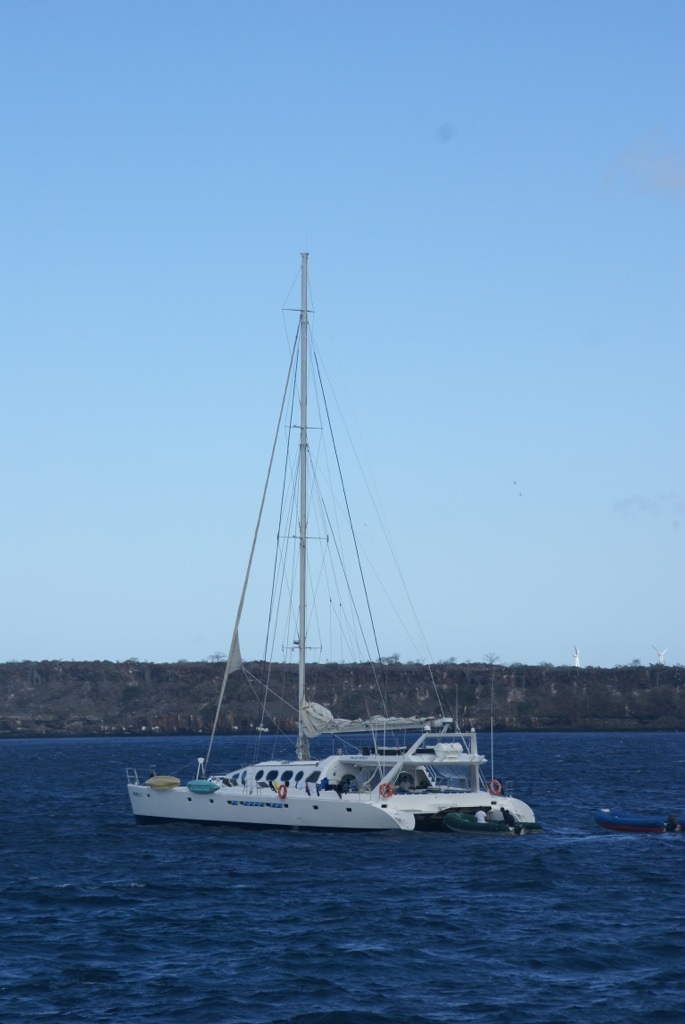
Well not exactly, we went to the Galapagos for a much anticipated week of exploring the islands.
The Galapagos Islands are about 1000kms away from South America in the Pacific Ocean. Their position on the Nazca plate that is slowly drifting eastwards and under the South American tectonic plate and above a volcanic hotspot means that the islands were formed from many eruptions. These happened at different times, so the islands are of different ages. The youngest ones still have black cones of larva fields without life even plants, whilst the oldest have eroded almost completely away. Those in their middle age, especially those with high enough volcanic peaks to attract rain are more lush and green.
Straight off the plane and onto the boat, our first stop after lunch was the small island of Seymour. The male Magnificent Frigate birds puff up their red throats to attract a mate, while sitting on a nest. The females then cruise past a few metres from the ground checking out their potential partners and their chosen spot. The male's throat looks so ridiculously enlarged, like it has a giant red pepper tucked under its chin.
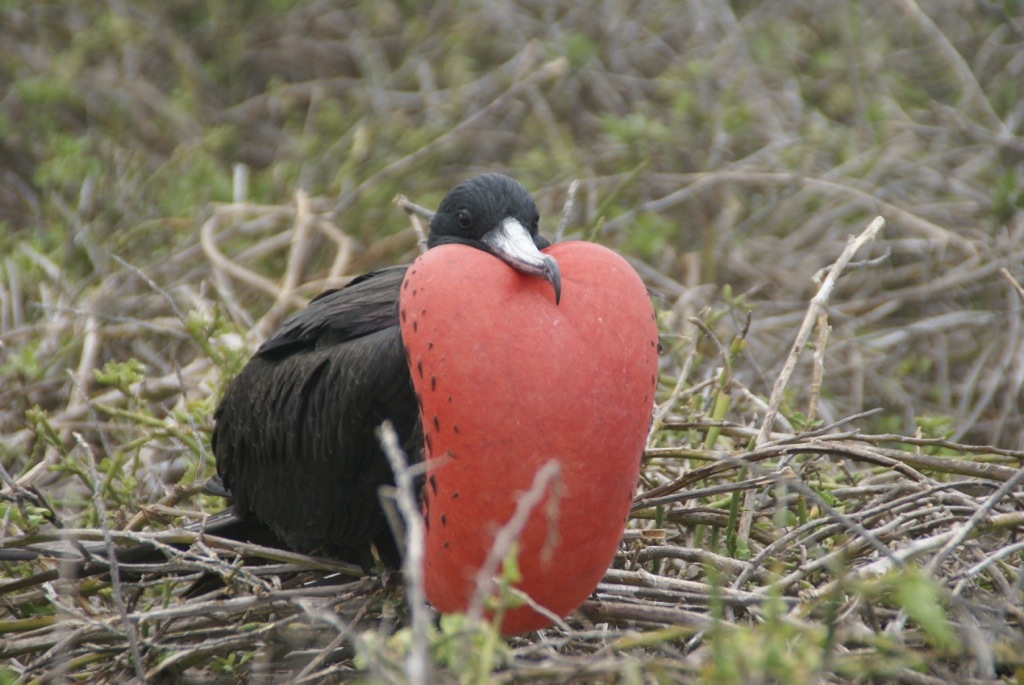
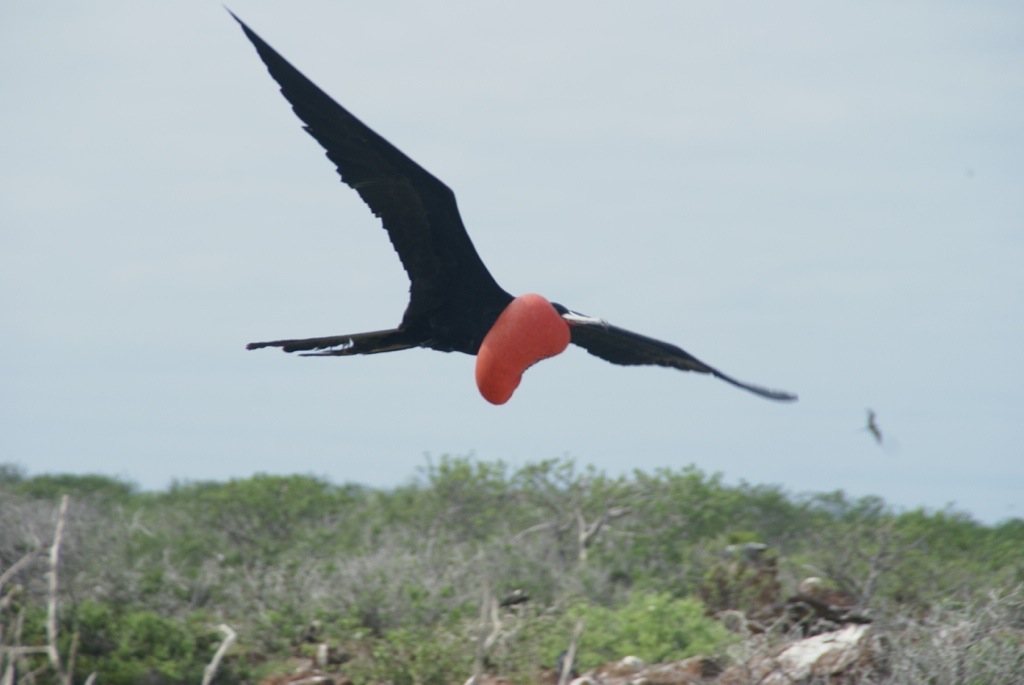
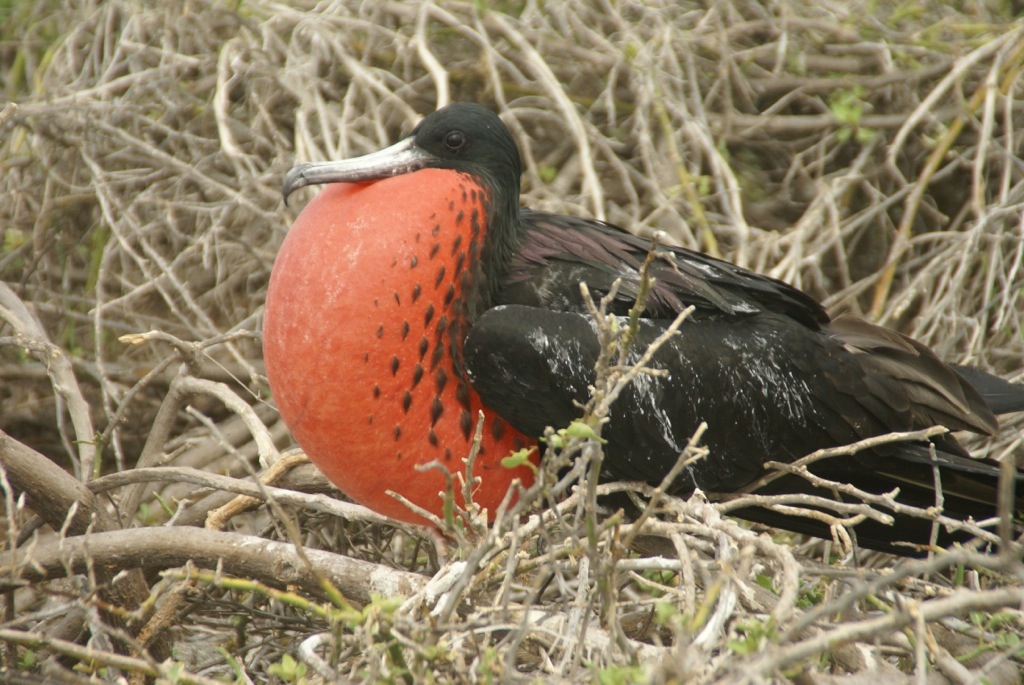
Also on the island was the bird Lucy had been looking forward to most, the Blue Footed Boobie. Bright turquoise feet, smooth circle of sand and a funky dance are the best way to attract a mate in the Boobie world.
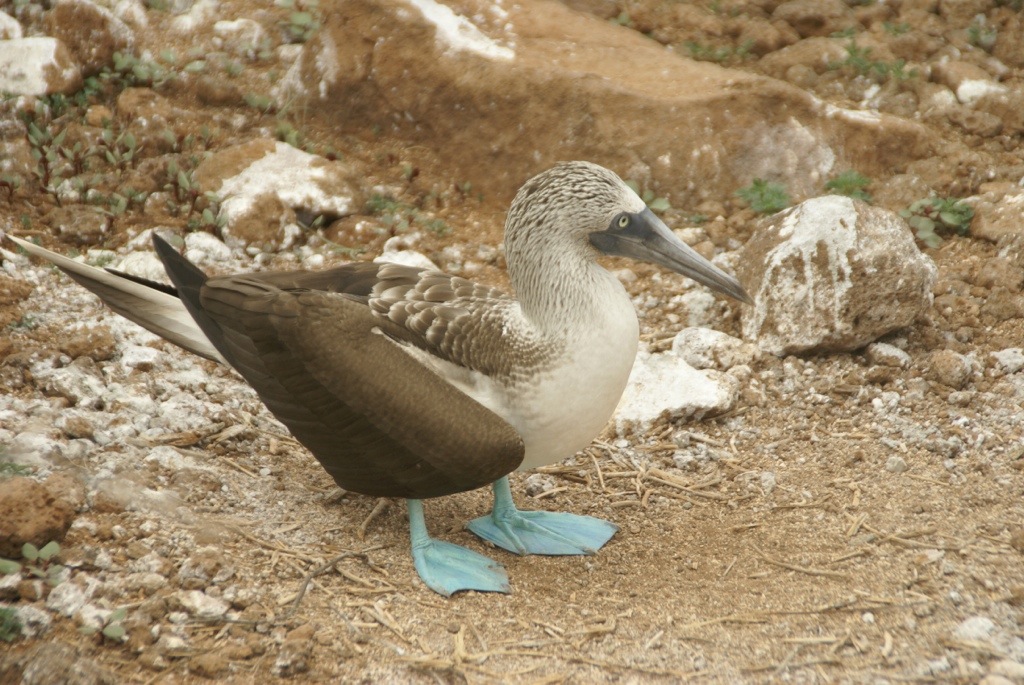

The island was really a great first day taster of some of the delights we were going to see this week with Galapagos Sea-lions, Land Iguanas, Larva Lizards and lots of birds.
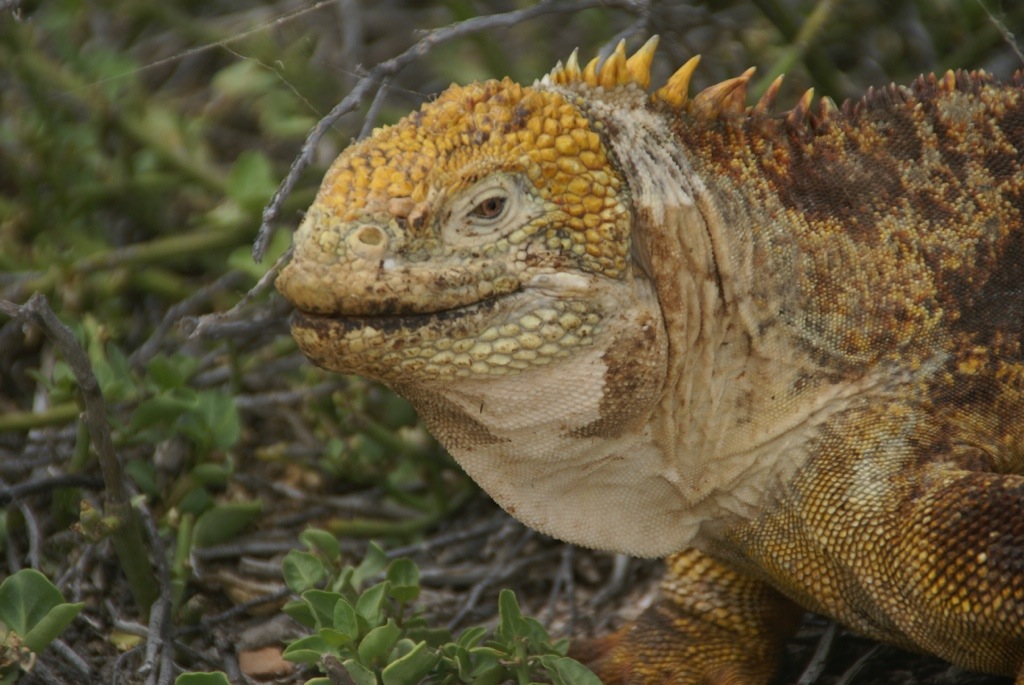
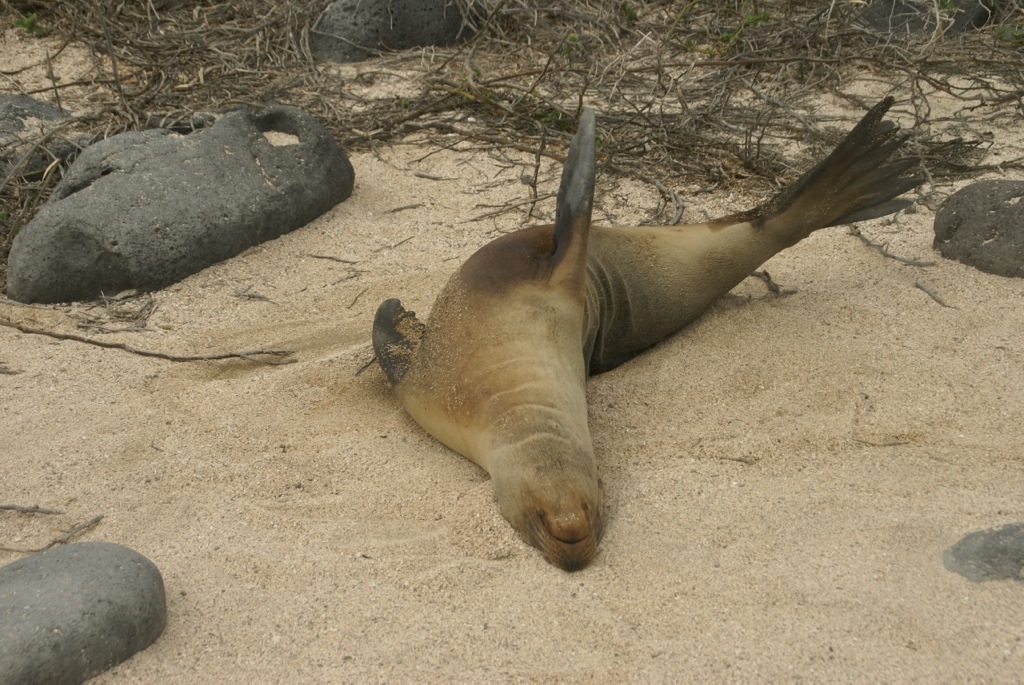
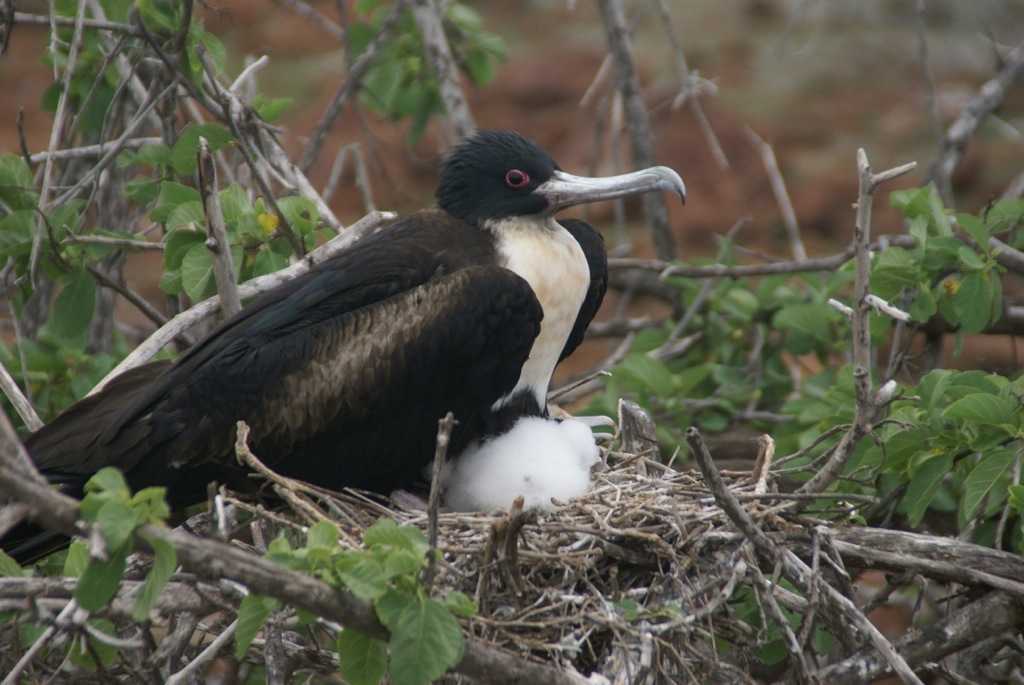
That night as we motored to the next island, we also got a taste of something we were going to see quite a bit of: rough seas. The captain set sail just after dinner, and as our expected smooth sailing got rougher and rougher that extra helping of pudding seemed like a bad idea. I don't think I was the only one to lose my delicious meal over the side as the tablets wore off. Not able to face rocking the bunks below, we collapsed in a family heap in the seating area outside in the back. When we moored up at 10.30, Steve and I exhaustedly carried the sleeping girls to their beds before we passed out below.
The following morning we awoke in a calm bay near the town of Porto Ayora to find all was good with the world again. Nemo II is a 21m catamaran for 12 guests with comfortable cabins, Lucy and I were sharing one with 6 foot high bunks, but she was happy to swap to her own special mini-bed made up on a bench at a safer height. The other 8 guests of a variety of ages and nationalities were a fun lot and our guide Carlos was very knowledgable and informative. There were also 6 crew on board, so all our needs are very well looked after.
Santa Cruz is one of the middle-aged islands so it has a variety of climates with lush green highlands. We took a bus up to where the tortoises were migrating to from lower elevations. A few times the bus driver had to pull off the road to pass these ancient looking beasts.
The primeval sound grunting from the edge of the lake was the give away that there was some giant Galapagos tortoise love making going on. Not one for flowers and romance a male tortoises idea of wooing a lady is chasing her under a bush till she gets stuck, then jumping on top. This male was massive, so I don't think the female was very happy, we couldn't even see her head, so I hope he hadn't downed her in the amorous encounter.

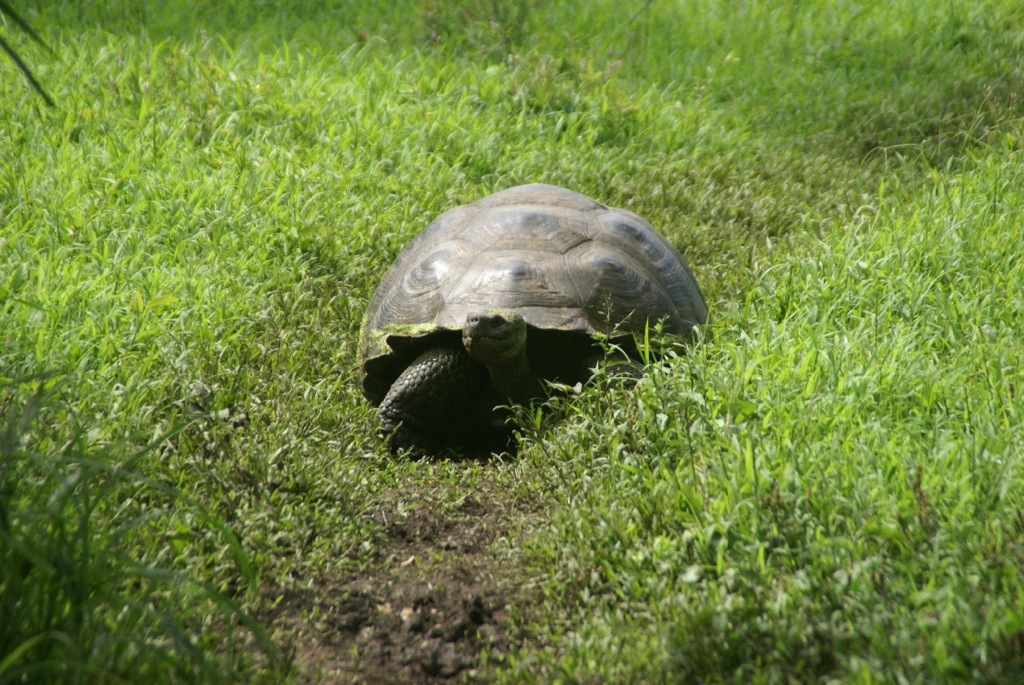
Back down by the shore, we went to the Charles Darwin Breeding Centre, where different species from the different islands are being bred for reintroduction to the wild. The tortoises on different islands have evolved into different species due to their need to adapt to the harsh environment and the geographical isolation. Those species found on very arid islands have evolved high saddleback shells at the fronts so they can then use their longer necks to reach for vegetation in low bushes that grow there. Rounder shelled species of tortoises are found on greener islands, where food is easier to reach.
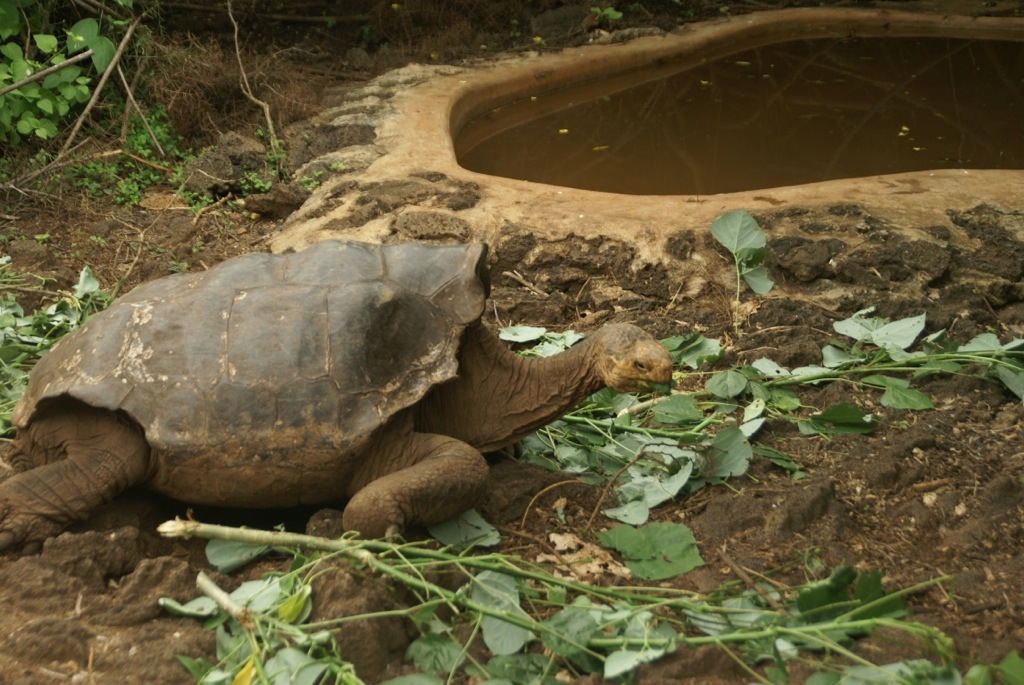
Pirates, buccaneers and sailors over the centuries have used the Galapagos as place to restock their boats. The Giant Tortoises were an ideal source of fresh meat, as they can live for a year without food or water. This not only decimated the tortoise populations on some islands but also mixed them up as smaller specimens were abandoned on different islands when swapped for meatier relatives. As well as breeding them the Centre has been making sure the right tortoises are on the right islands.
The captain told us to expect a rough night's sail to Isabela Island and we all hunkered down early for the night dosed up with sea sickness pills, we woke up delighted and refreshed after a calm night.
The larva fields of Isabela are stark and empty only punctuated with green lagoons which are home to Greater Flamingos.

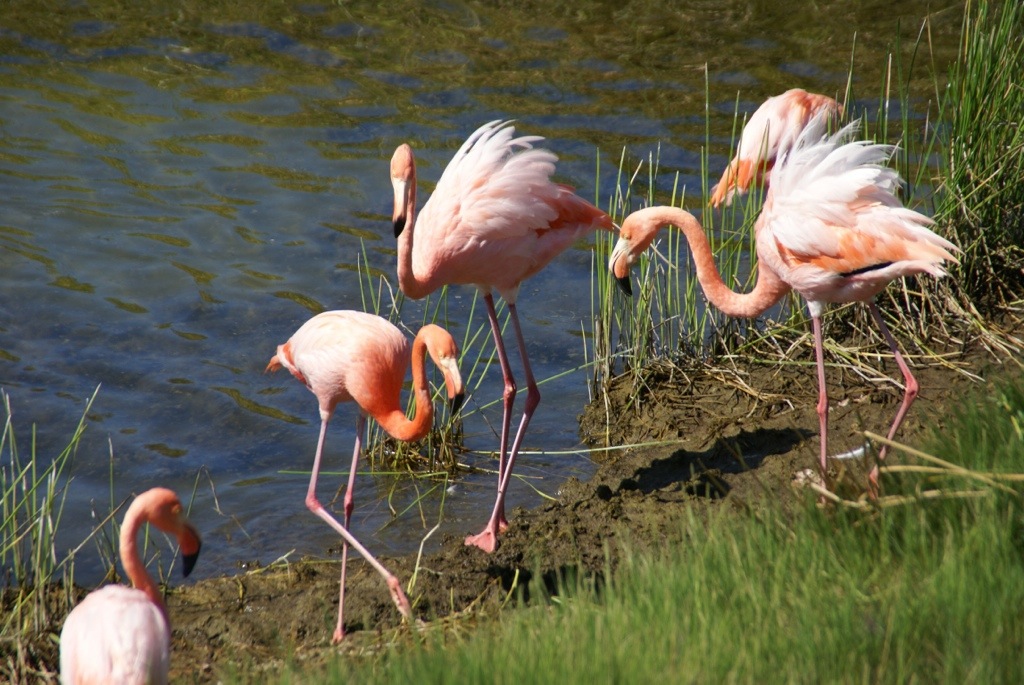
Snorkelling from a small boat we saw many Green Pacific Turtles, bright fishes and even a Flightless Cormorant diving for fish. Further around the island is covered with short trees and grasses, an ideal environment for tortoises, land iguanas and many, many birds.
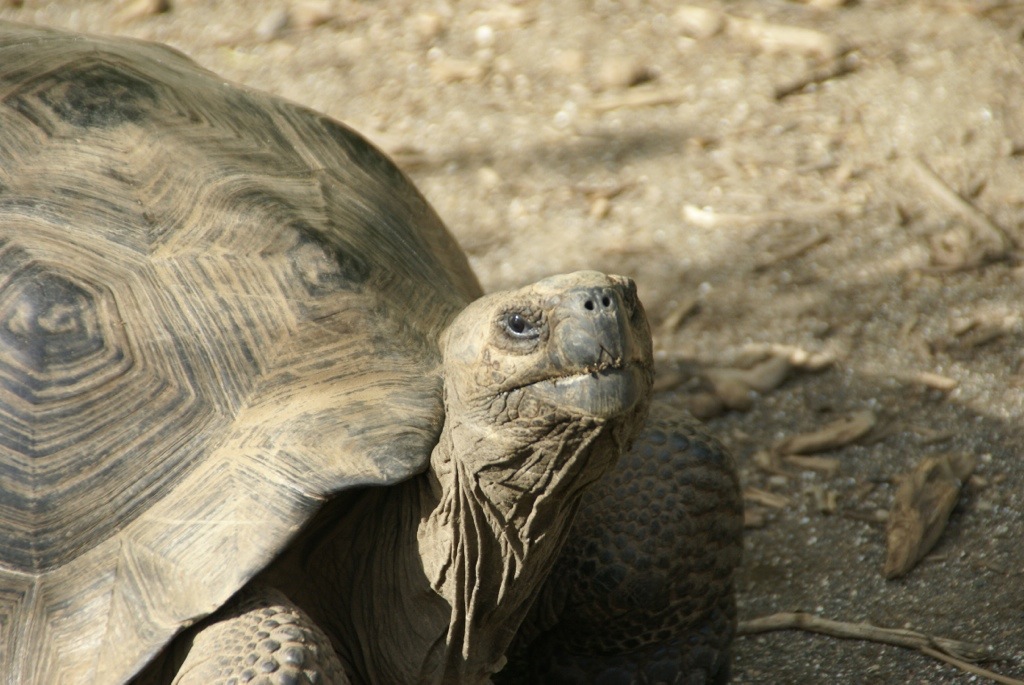
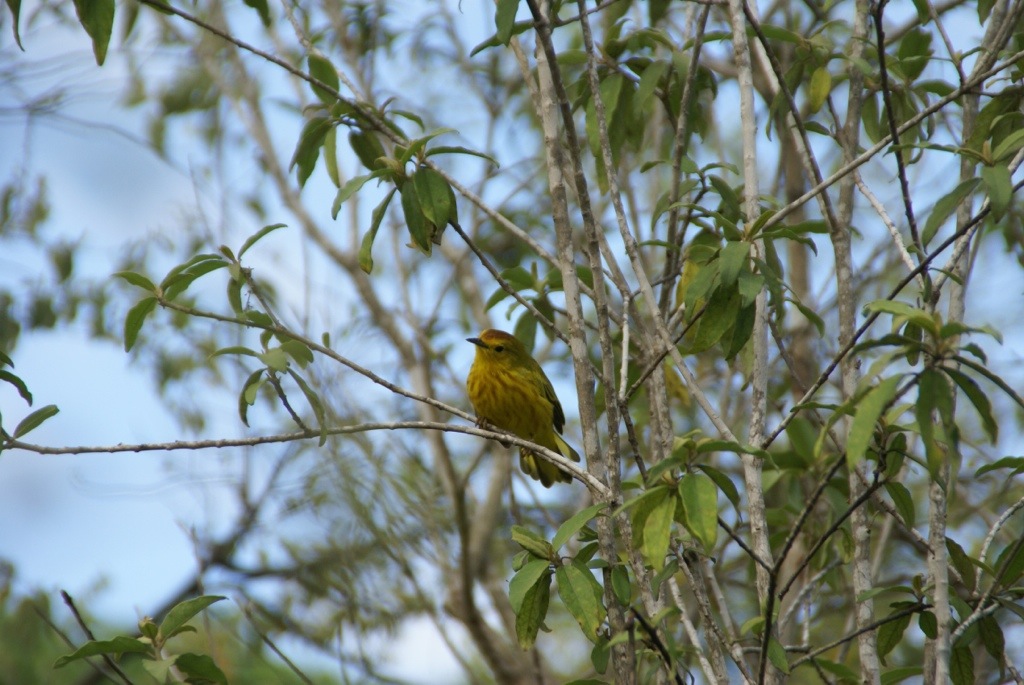
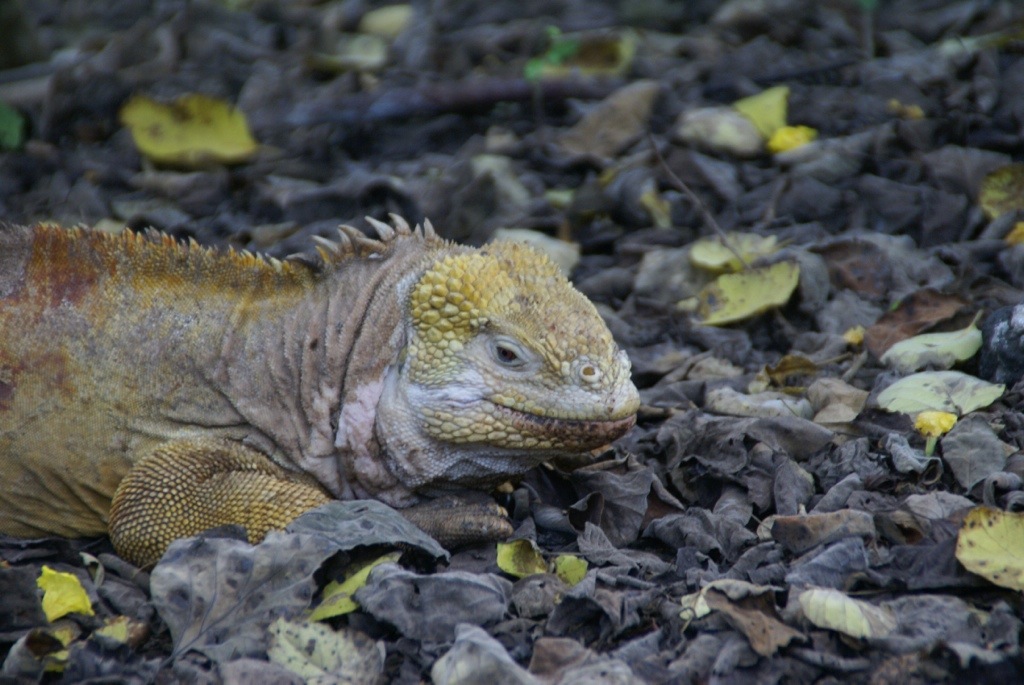
One thing that really strikes us about these islands is the lack of fear that all the species seem to have for humans. Being a national park, tourists are kept to a restricted area, always have to be accompanied by a guide and have to behave in a low impact way but it amazes us at how unconcerned everything seemed about our presence. The famed Galapagos Finches flited from branch to branch just above our heads, tortoises continued on their path past us and sea lions didn't even acknowledge our presence when we had to squeeze past them as they were sunning themselves on boat landing platforms. The rule is that we had to stay at least 2m from the animals but no one seems to have told the animals that. A tortoise came lumbering out of the bushes just feet from where Steve and the girls were standing and seemed very curious about what type of creatures they might be.
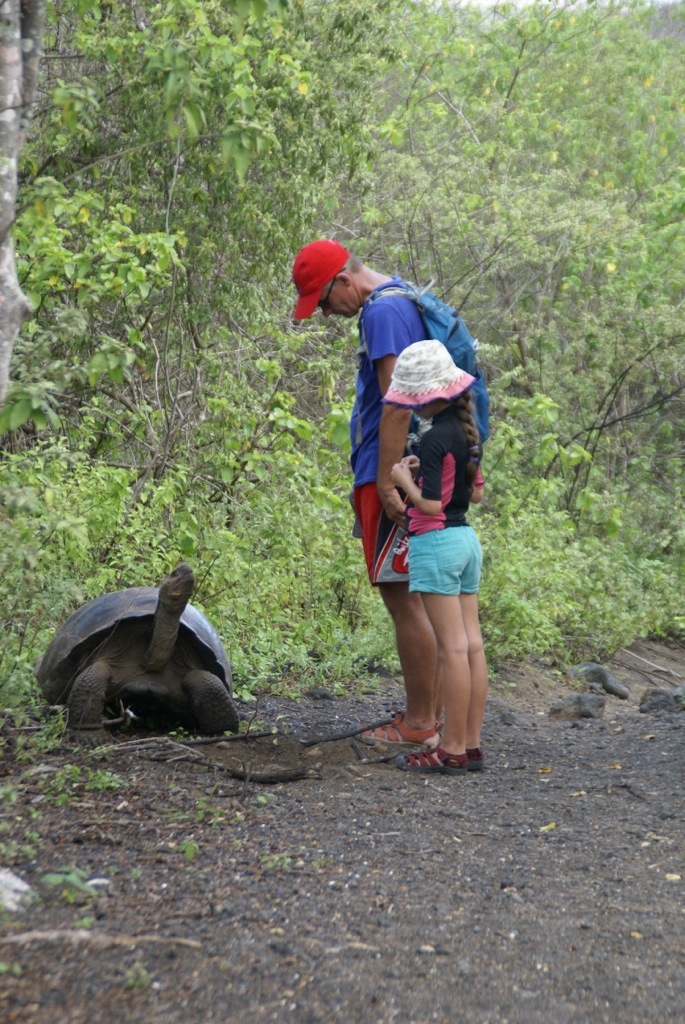
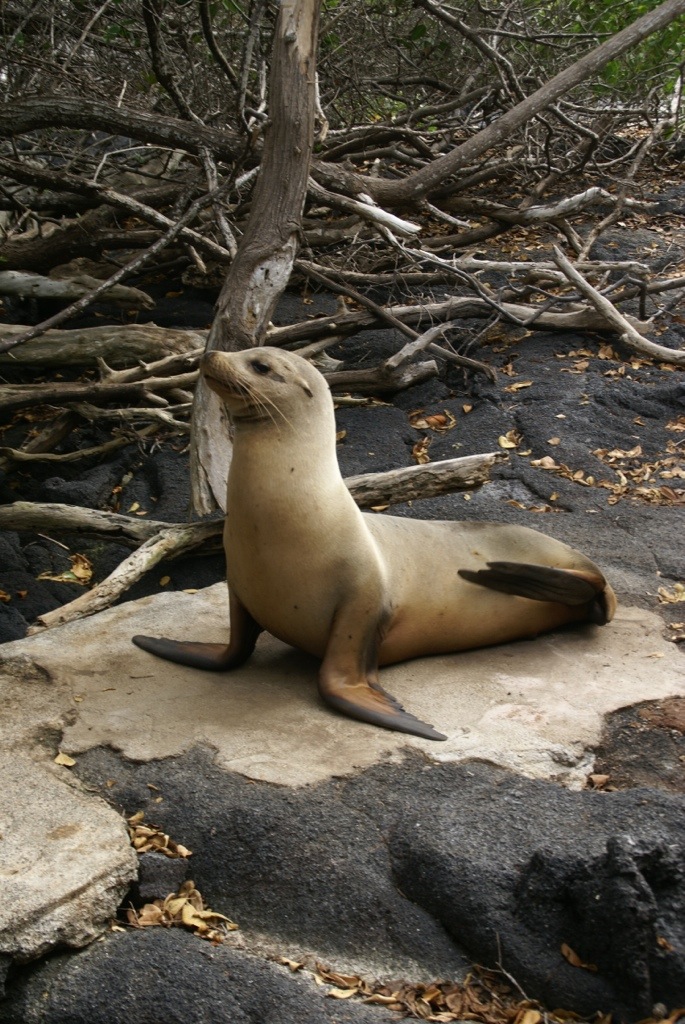
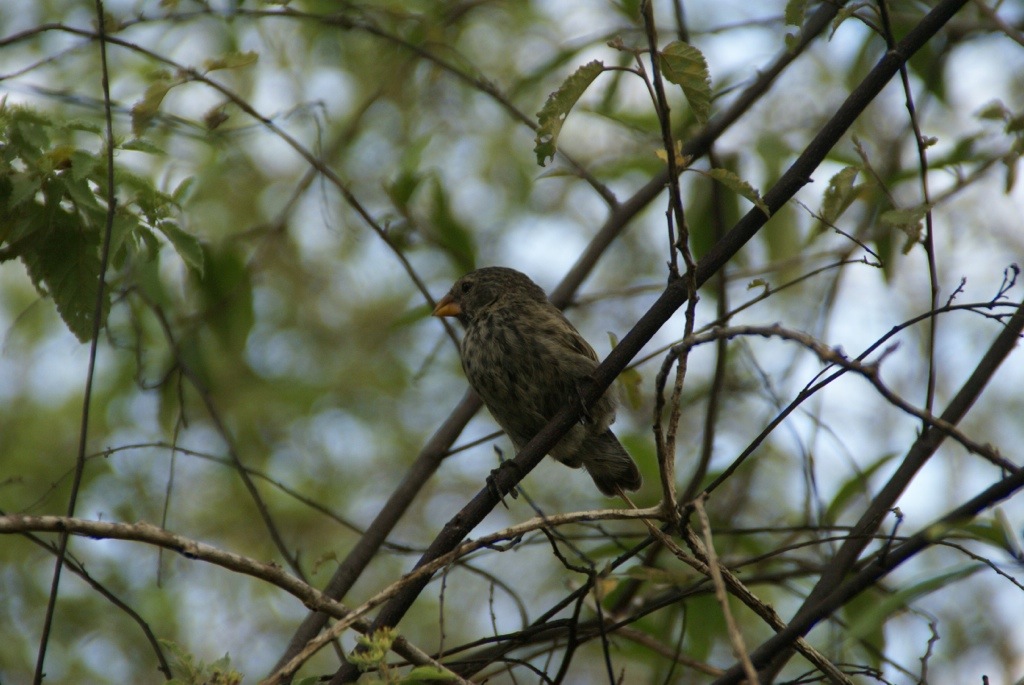
Down on the shore the following day still on Isabela, were two of my favourite species: the brightly coloured Sally Lightfoot Crabs and the Marine Iguanas.
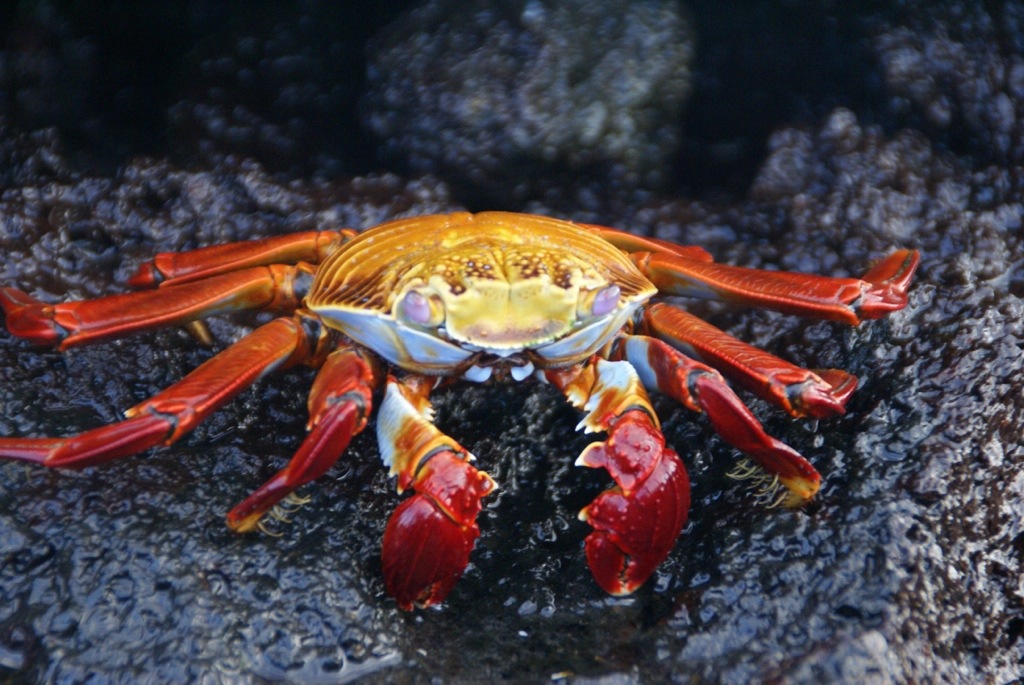
Marine Iguanas are a completely different species from their land-based ancestors. Millions of years ago in South America, after heavy rain, patches of vegetation were swept into rivers and out to sea. In that vegetation, scientists believe, were Land Iguanas. Being reptiles they could survive for a long time without water or much food and so were able to make the 1000km plus journey across the Pacific. Eventually some were washed up on the Galapagos Islands. With little vegetation available on these larva-field filled volcanic islands, some of the arrivals turned to sea weed to survive. Over millions of years they have evolved to have shorter snouts, more paddle like tails for swimming and strong claws for climbing the rocks. The larger ones dive down into the crashing seas to get to the algae growing on submerged rocks. As iguanas are cold blooded animals, they have to return to the rocks regularly to bask in the warm sun. They are now black, so they can absorb more warmth. As for the dangerous built up of salt from the seawater, they've evolved to sneeze it out. Passing a colony of Marine Iguanas is a bit like being in a doctor's waiting room in November with a continuous stream of sneezes assaulting you.
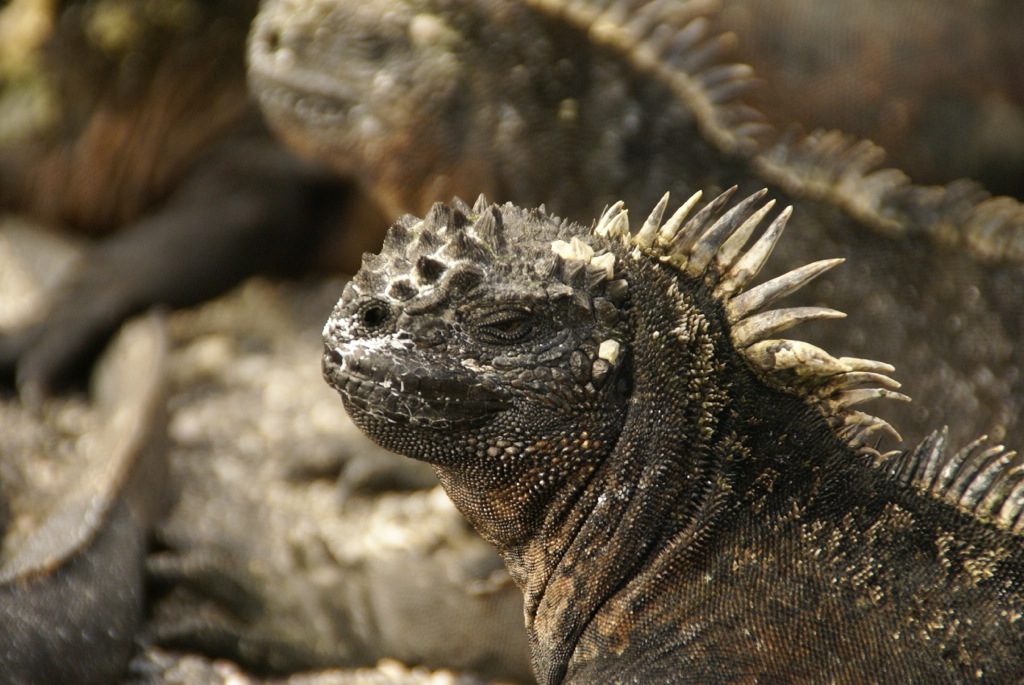
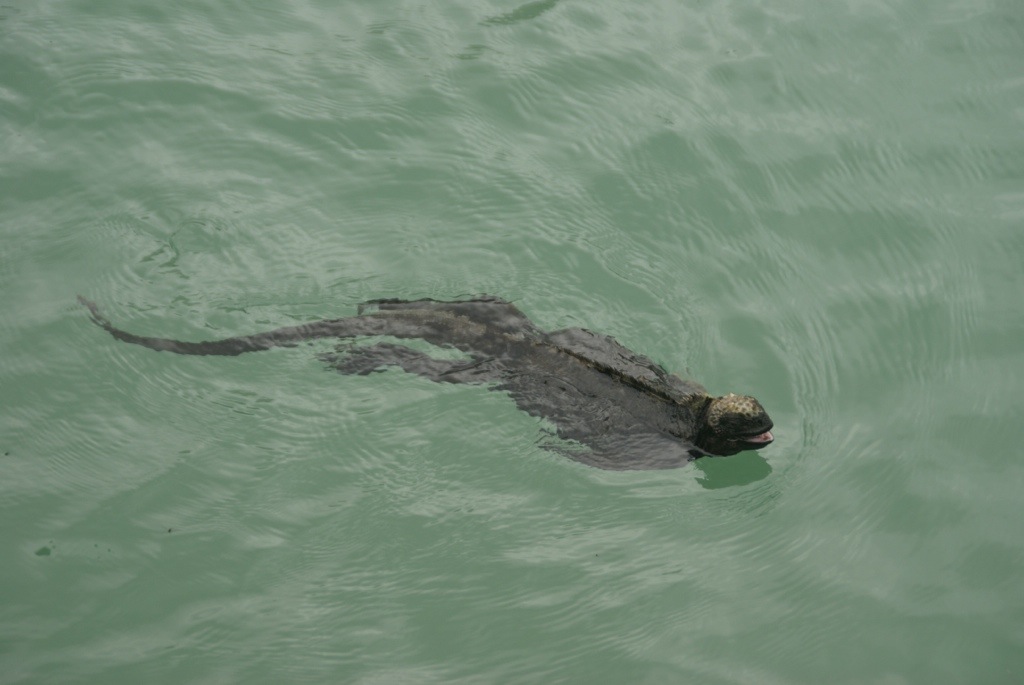
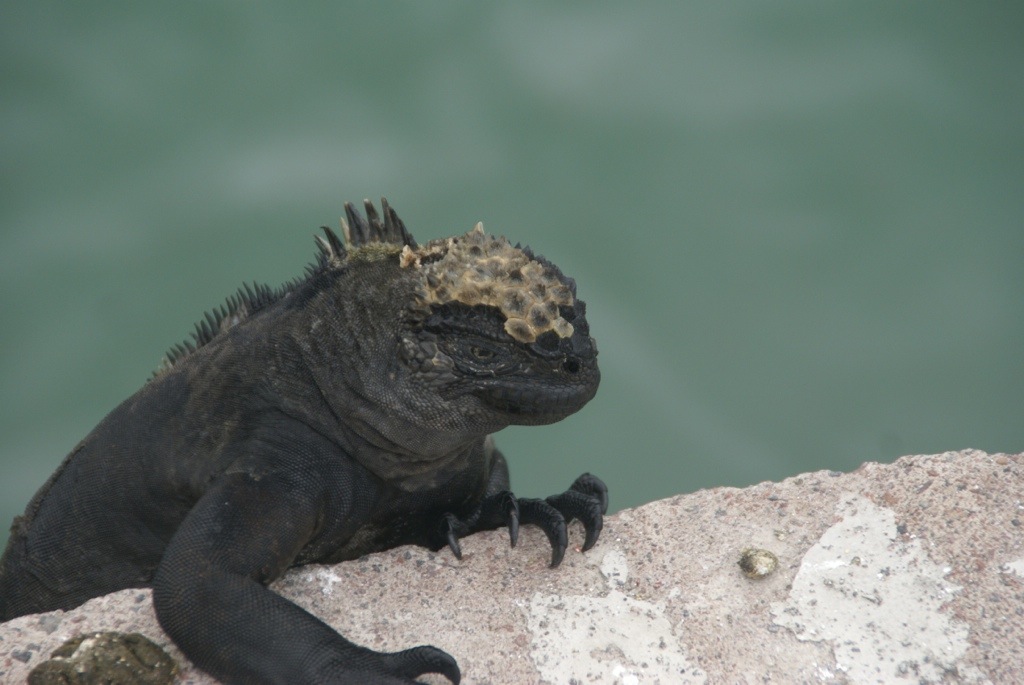
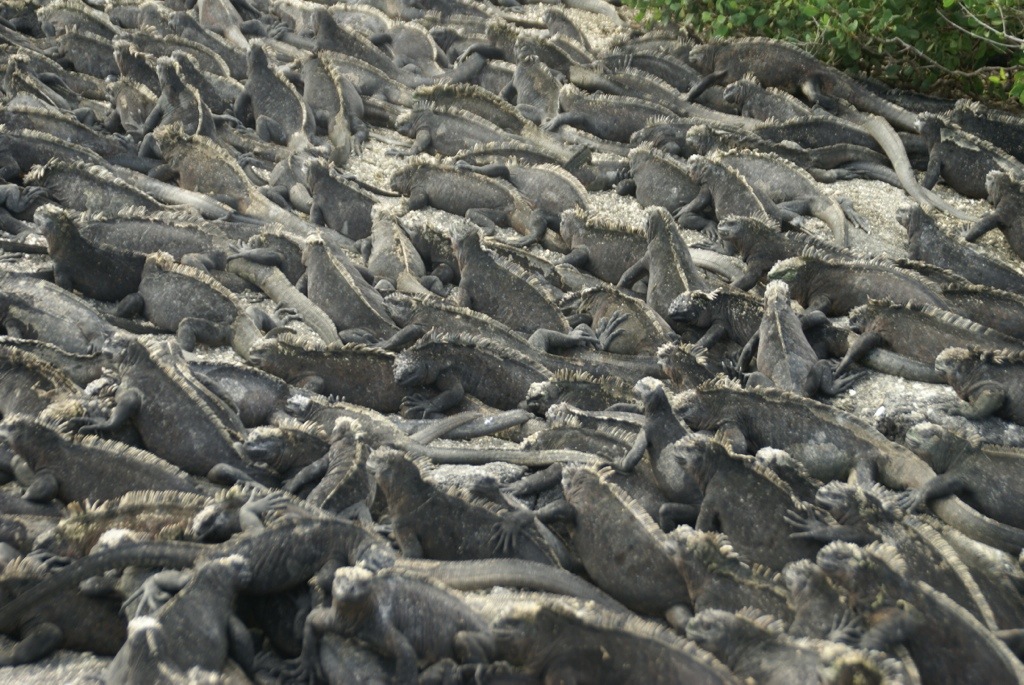
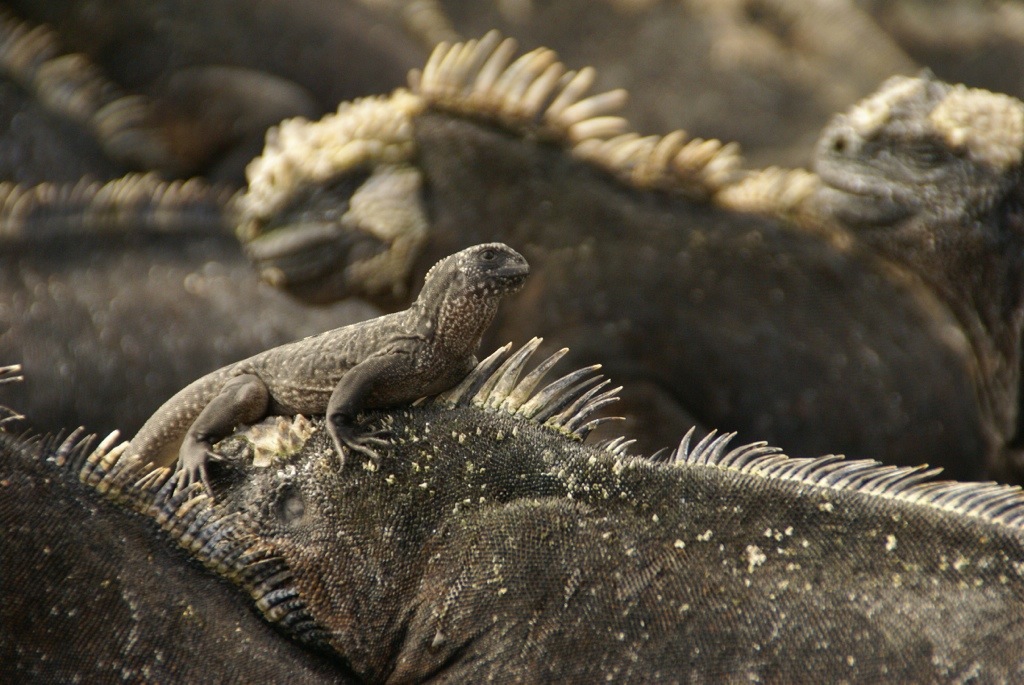
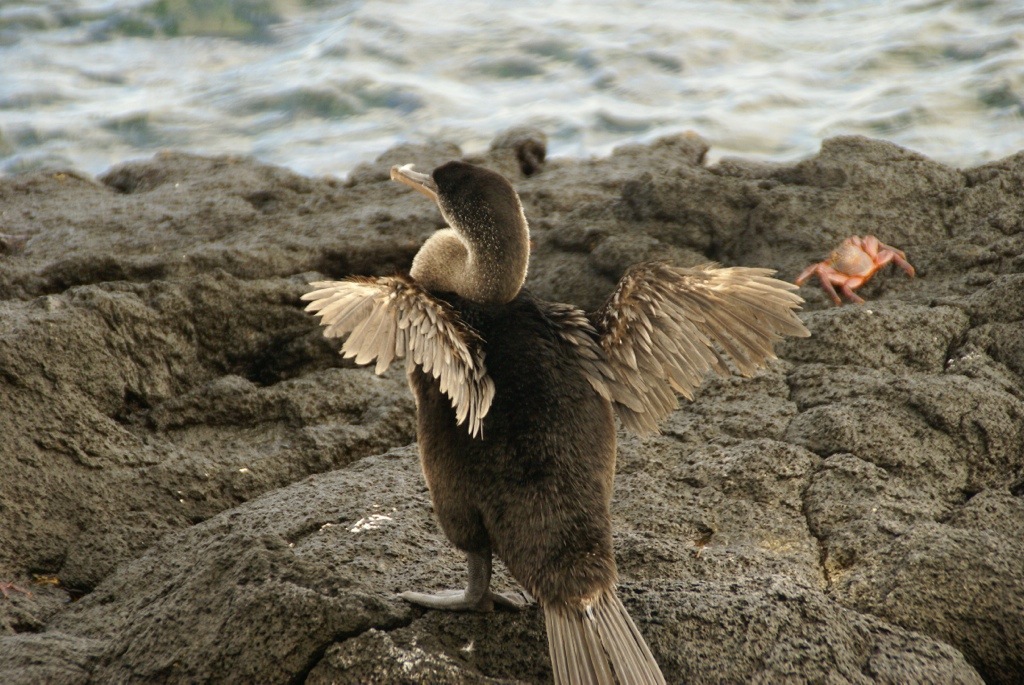
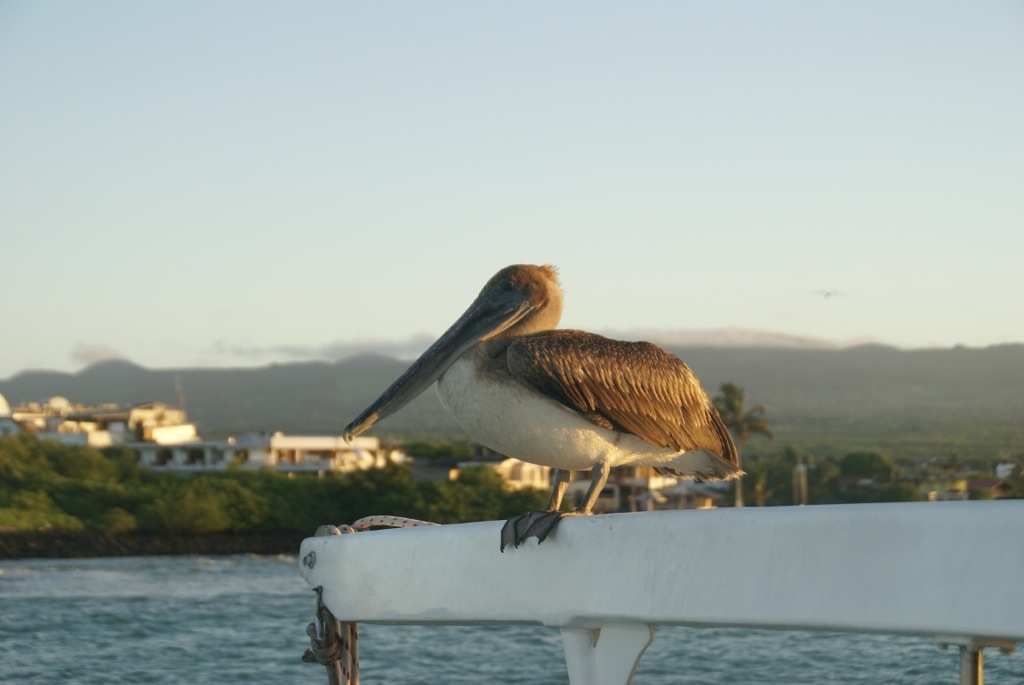

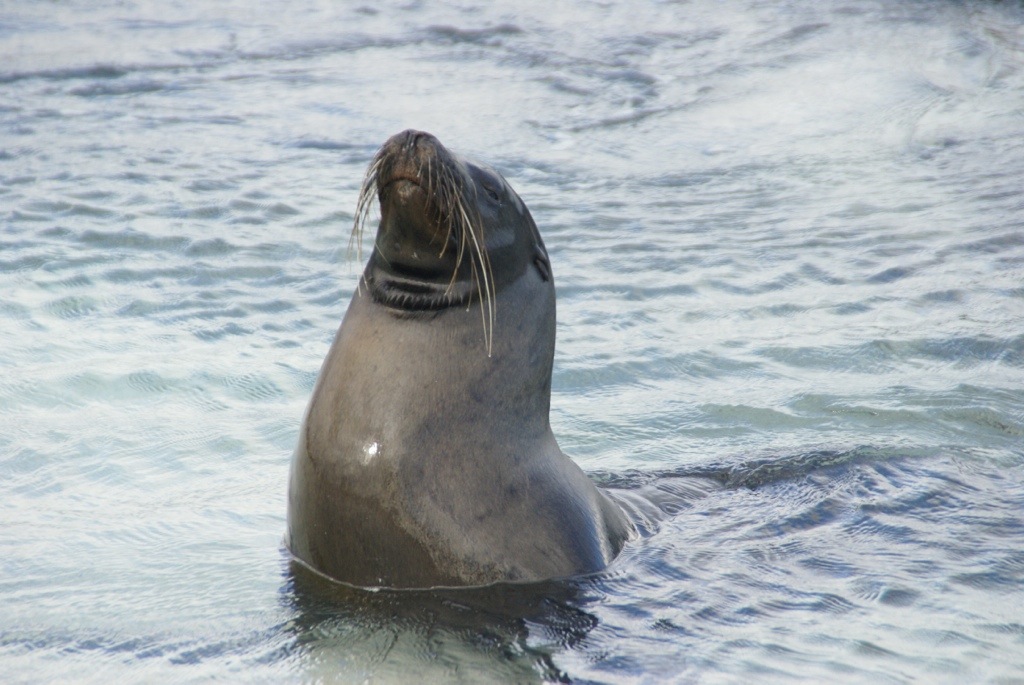

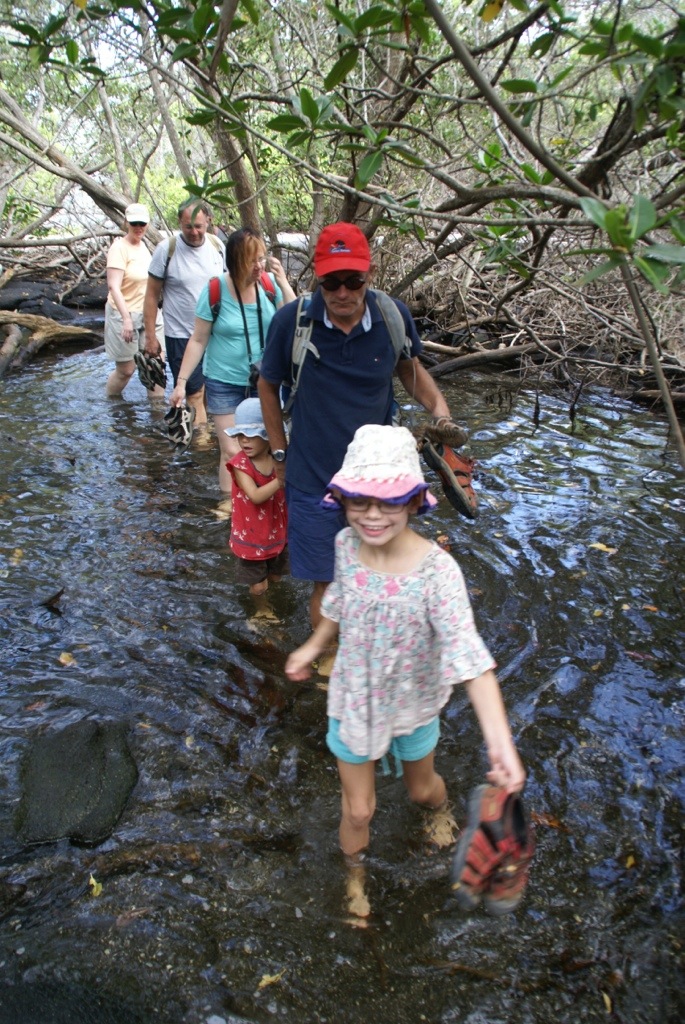
 Well not exactly, we went to the Galapagos for a much anticipated week of exploring the islands.
The Galapagos Islands are about 1000kms away from South America in the Pacific Ocean. Their position on the Nazca plate that is slowly drifting eastwards and under the South American tectonic plate and above a volcanic hotspot means that the islands were formed from many eruptions. These happened at different times, so the islands are of different ages. The youngest ones still have black cones of larva fields without life even plants, whilst the oldest have eroded almost completely away. Those in their middle age, especially those with high enough volcanic peaks to attract rain are more lush and green.
Straight off the plane and onto the boat, our first stop after lunch was the small island of Seymour. The male Magnificent Frigate birds puff up their red throats to attract a mate, while sitting on a nest. The females then cruise past a few metres from the ground checking out their potential partners and their chosen spot. The male's throat looks so ridiculously enlarged, like it has a giant red pepper tucked under its chin.
Well not exactly, we went to the Galapagos for a much anticipated week of exploring the islands.
The Galapagos Islands are about 1000kms away from South America in the Pacific Ocean. Their position on the Nazca plate that is slowly drifting eastwards and under the South American tectonic plate and above a volcanic hotspot means that the islands were formed from many eruptions. These happened at different times, so the islands are of different ages. The youngest ones still have black cones of larva fields without life even plants, whilst the oldest have eroded almost completely away. Those in their middle age, especially those with high enough volcanic peaks to attract rain are more lush and green.
Straight off the plane and onto the boat, our first stop after lunch was the small island of Seymour. The male Magnificent Frigate birds puff up their red throats to attract a mate, while sitting on a nest. The females then cruise past a few metres from the ground checking out their potential partners and their chosen spot. The male's throat looks so ridiculously enlarged, like it has a giant red pepper tucked under its chin.


 Also on the island was the bird Lucy had been looking forward to most, the Blue Footed Boobie. Bright turquoise feet, smooth circle of sand and a funky dance are the best way to attract a mate in the Boobie world.
Also on the island was the bird Lucy had been looking forward to most, the Blue Footed Boobie. Bright turquoise feet, smooth circle of sand and a funky dance are the best way to attract a mate in the Boobie world.

 The island was really a great first day taster of some of the delights we were going to see this week with Galapagos Sea-lions, Land Iguanas, Larva Lizards and lots of birds.
The island was really a great first day taster of some of the delights we were going to see this week with Galapagos Sea-lions, Land Iguanas, Larva Lizards and lots of birds.


 That night as we motored to the next island, we also got a taste of something we were going to see quite a bit of: rough seas. The captain set sail just after dinner, and as our expected smooth sailing got rougher and rougher that extra helping of pudding seemed like a bad idea. I don't think I was the only one to lose my delicious meal over the side as the tablets wore off. Not able to face rocking the bunks below, we collapsed in a family heap in the seating area outside in the back. When we moored up at 10.30, Steve and I exhaustedly carried the sleeping girls to their beds before we passed out below.
The following morning we awoke in a calm bay near the town of Porto Ayora to find all was good with the world again. Nemo II is a 21m catamaran for 12 guests with comfortable cabins, Lucy and I were sharing one with 6 foot high bunks, but she was happy to swap to her own special mini-bed made up on a bench at a safer height. The other 8 guests of a variety of ages and nationalities were a fun lot and our guide Carlos was very knowledgable and informative. There were also 6 crew on board, so all our needs are very well looked after.
Santa Cruz is one of the middle-aged islands so it has a variety of climates with lush green highlands. We took a bus up to where the tortoises were migrating to from lower elevations. A few times the bus driver had to pull off the road to pass these ancient looking beasts.
The primeval sound grunting from the edge of the lake was the give away that there was some giant Galapagos tortoise love making going on. Not one for flowers and romance a male tortoises idea of wooing a lady is chasing her under a bush till she gets stuck, then jumping on top. This male was massive, so I don't think the female was very happy, we couldn't even see her head, so I hope he hadn't downed her in the amorous encounter.
That night as we motored to the next island, we also got a taste of something we were going to see quite a bit of: rough seas. The captain set sail just after dinner, and as our expected smooth sailing got rougher and rougher that extra helping of pudding seemed like a bad idea. I don't think I was the only one to lose my delicious meal over the side as the tablets wore off. Not able to face rocking the bunks below, we collapsed in a family heap in the seating area outside in the back. When we moored up at 10.30, Steve and I exhaustedly carried the sleeping girls to their beds before we passed out below.
The following morning we awoke in a calm bay near the town of Porto Ayora to find all was good with the world again. Nemo II is a 21m catamaran for 12 guests with comfortable cabins, Lucy and I were sharing one with 6 foot high bunks, but she was happy to swap to her own special mini-bed made up on a bench at a safer height. The other 8 guests of a variety of ages and nationalities were a fun lot and our guide Carlos was very knowledgable and informative. There were also 6 crew on board, so all our needs are very well looked after.
Santa Cruz is one of the middle-aged islands so it has a variety of climates with lush green highlands. We took a bus up to where the tortoises were migrating to from lower elevations. A few times the bus driver had to pull off the road to pass these ancient looking beasts.
The primeval sound grunting from the edge of the lake was the give away that there was some giant Galapagos tortoise love making going on. Not one for flowers and romance a male tortoises idea of wooing a lady is chasing her under a bush till she gets stuck, then jumping on top. This male was massive, so I don't think the female was very happy, we couldn't even see her head, so I hope he hadn't downed her in the amorous encounter.

 Back down by the shore, we went to the Charles Darwin Breeding Centre, where different species from the different islands are being bred for reintroduction to the wild. The tortoises on different islands have evolved into different species due to their need to adapt to the harsh environment and the geographical isolation. Those species found on very arid islands have evolved high saddleback shells at the fronts so they can then use their longer necks to reach for vegetation in low bushes that grow there. Rounder shelled species of tortoises are found on greener islands, where food is easier to reach.
Back down by the shore, we went to the Charles Darwin Breeding Centre, where different species from the different islands are being bred for reintroduction to the wild. The tortoises on different islands have evolved into different species due to their need to adapt to the harsh environment and the geographical isolation. Those species found on very arid islands have evolved high saddleback shells at the fronts so they can then use their longer necks to reach for vegetation in low bushes that grow there. Rounder shelled species of tortoises are found on greener islands, where food is easier to reach.
 Pirates, buccaneers and sailors over the centuries have used the Galapagos as place to restock their boats. The Giant Tortoises were an ideal source of fresh meat, as they can live for a year without food or water. This not only decimated the tortoise populations on some islands but also mixed them up as smaller specimens were abandoned on different islands when swapped for meatier relatives. As well as breeding them the Centre has been making sure the right tortoises are on the right islands.
The captain told us to expect a rough night's sail to Isabela Island and we all hunkered down early for the night dosed up with sea sickness pills, we woke up delighted and refreshed after a calm night.
The larva fields of Isabela are stark and empty only punctuated with green lagoons which are home to Greater Flamingos.
Pirates, buccaneers and sailors over the centuries have used the Galapagos as place to restock their boats. The Giant Tortoises were an ideal source of fresh meat, as they can live for a year without food or water. This not only decimated the tortoise populations on some islands but also mixed them up as smaller specimens were abandoned on different islands when swapped for meatier relatives. As well as breeding them the Centre has been making sure the right tortoises are on the right islands.
The captain told us to expect a rough night's sail to Isabela Island and we all hunkered down early for the night dosed up with sea sickness pills, we woke up delighted and refreshed after a calm night.
The larva fields of Isabela are stark and empty only punctuated with green lagoons which are home to Greater Flamingos.

 Snorkelling from a small boat we saw many Green Pacific Turtles, bright fishes and even a Flightless Cormorant diving for fish. Further around the island is covered with short trees and grasses, an ideal environment for tortoises, land iguanas and many, many birds.
Snorkelling from a small boat we saw many Green Pacific Turtles, bright fishes and even a Flightless Cormorant diving for fish. Further around the island is covered with short trees and grasses, an ideal environment for tortoises, land iguanas and many, many birds.


 One thing that really strikes us about these islands is the lack of fear that all the species seem to have for humans. Being a national park, tourists are kept to a restricted area, always have to be accompanied by a guide and have to behave in a low impact way but it amazes us at how unconcerned everything seemed about our presence. The famed Galapagos Finches flited from branch to branch just above our heads, tortoises continued on their path past us and sea lions didn't even acknowledge our presence when we had to squeeze past them as they were sunning themselves on boat landing platforms. The rule is that we had to stay at least 2m from the animals but no one seems to have told the animals that. A tortoise came lumbering out of the bushes just feet from where Steve and the girls were standing and seemed very curious about what type of creatures they might be.
One thing that really strikes us about these islands is the lack of fear that all the species seem to have for humans. Being a national park, tourists are kept to a restricted area, always have to be accompanied by a guide and have to behave in a low impact way but it amazes us at how unconcerned everything seemed about our presence. The famed Galapagos Finches flited from branch to branch just above our heads, tortoises continued on their path past us and sea lions didn't even acknowledge our presence when we had to squeeze past them as they were sunning themselves on boat landing platforms. The rule is that we had to stay at least 2m from the animals but no one seems to have told the animals that. A tortoise came lumbering out of the bushes just feet from where Steve and the girls were standing and seemed very curious about what type of creatures they might be.


 Down on the shore the following day still on Isabela, were two of my favourite species: the brightly coloured Sally Lightfoot Crabs and the Marine Iguanas.
Down on the shore the following day still on Isabela, were two of my favourite species: the brightly coloured Sally Lightfoot Crabs and the Marine Iguanas.
 Marine Iguanas are a completely different species from their land-based ancestors. Millions of years ago in South America, after heavy rain, patches of vegetation were swept into rivers and out to sea. In that vegetation, scientists believe, were Land Iguanas. Being reptiles they could survive for a long time without water or much food and so were able to make the 1000km plus journey across the Pacific. Eventually some were washed up on the Galapagos Islands. With little vegetation available on these larva-field filled volcanic islands, some of the arrivals turned to sea weed to survive. Over millions of years they have evolved to have shorter snouts, more paddle like tails for swimming and strong claws for climbing the rocks. The larger ones dive down into the crashing seas to get to the algae growing on submerged rocks. As iguanas are cold blooded animals, they have to return to the rocks regularly to bask in the warm sun. They are now black, so they can absorb more warmth. As for the dangerous built up of salt from the seawater, they've evolved to sneeze it out. Passing a colony of Marine Iguanas is a bit like being in a doctor's waiting room in November with a continuous stream of sneezes assaulting you.
Marine Iguanas are a completely different species from their land-based ancestors. Millions of years ago in South America, after heavy rain, patches of vegetation were swept into rivers and out to sea. In that vegetation, scientists believe, were Land Iguanas. Being reptiles they could survive for a long time without water or much food and so were able to make the 1000km plus journey across the Pacific. Eventually some were washed up on the Galapagos Islands. With little vegetation available on these larva-field filled volcanic islands, some of the arrivals turned to sea weed to survive. Over millions of years they have evolved to have shorter snouts, more paddle like tails for swimming and strong claws for climbing the rocks. The larger ones dive down into the crashing seas to get to the algae growing on submerged rocks. As iguanas are cold blooded animals, they have to return to the rocks regularly to bask in the warm sun. They are now black, so they can absorb more warmth. As for the dangerous built up of salt from the seawater, they've evolved to sneeze it out. Passing a colony of Marine Iguanas is a bit like being in a doctor's waiting room in November with a continuous stream of sneezes assaulting you.












Pictures as good as National Geographic’s! Even better because you were there!
Chris and Steve
Many thanks. We absolutely loved been there.